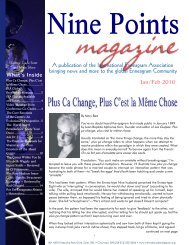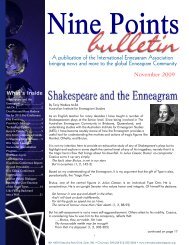Nine Points Magazine - International Enneagram Association
Nine Points Magazine - International Enneagram Association
Nine Points Magazine - International Enneagram Association
Create successful ePaper yourself
Turn your PDF publications into a flip-book with our unique Google optimized e-Paper software.
Opinions are related to preferences, but they add a quasiintellectual<br />
element because we have given some thought to<br />
them and devised at least a cursory rationale for our<br />
opinions. We may have more of a rationale for our<br />
opinions than we do for our preferences, but they are<br />
subjective nonetheless. For example, I can provide you with<br />
a detailed rationale for why<br />
is the greatest album ever recorded, or why the<br />
designated hitter cheapens baseball, but in my more<br />
generous and enlightened moments I must admit that these<br />
are not objective facts.<br />
The second category—first-person experience—gets a bit<br />
trickier.<br />
The most immediate example of first-person experience is<br />
our feelings. For example, physical pain is very subjective<br />
and we can never truly know what another person is<br />
experiencing when in pain. Doctors will ask a patient to<br />
rank their pain on a scale of one to ten, but there is no way<br />
to actually know what “one” is or what “ten” is; such a scale<br />
is just a tool to provide the doctor clues regarding the<br />
patient’s condition. The only data point a doctor can use to<br />
evaluate pain is the patient’s rating, so the doctor must be<br />
satisfied with this subjective way of knowing when making<br />
an evaluation. We can never truly know another’s physical<br />
or emotional pain, nor can we truly, objectively know their<br />
joys, so it would be impossible to create a scientific<br />
approach to understanding such things.<br />
Where the reliance on first-person experience starts to get<br />
messy is when it comes to our perception or recollection of<br />
factual events. Every student of the <strong>Enneagram</strong> knows that<br />
one of the biggest challenges we face is the difficulty of<br />
seeing ourselves and the world as they are, rather than as<br />
we they are. Spiritual traditions all talk about illusion<br />
in one form or another and our susceptibility to it; modern<br />
cognitive science talks about the many structural problems<br />
with the brain that cause us to misperceive our world. (Part<br />
II will discuss this in greater depth.)<br />
However, we fall into the trap of thinking that our<br />
perception of factual events (i.e., things that really happen)<br />
are objectively true. When our recollection differs from that<br />
of another, we automatically assume they are wrong, or<br />
settle on some version of an “I-have-my-truth-and-you-have<br />
yours” post-modernist détente that ultimately satisfies no<br />
one and gets us no closer to the Truth.<br />
What we commonly call “the scientific method” is an<br />
approach designed as an objective tool for understanding<br />
phenomena that be understood objectively. Granted,<br />
there is no single “scientific method” and the more<br />
complicated the phenomena in question the more<br />
complicated the method becomes. (Massimo Pigluicci’s new<br />
16<br />
book, , is a good guide to navigating<br />
these tricky waters.) However, the basic scientific method can<br />
be described as these four steps:<br />
1. Observe a series of events or phenomena.<br />
2. Form a hypothesis to explain them or make a<br />
prediction.<br />
3. Try to through a series of<br />
rigorous tests.<br />
4. Revise your hypothesis as necessary due to the<br />
outcome of the tests.<br />
The critical point of the scientific method is to attempt to falsify<br />
your hypothesis; in other words, to try to disprove what<br />
you believe to be true. In the same spirit, I would suggest<br />
that the to a scientific approach to the <strong>Enneagram</strong><br />
is to use it as a tool that helps us see through our illusions by<br />
challenging our ego-based assumptions rather than reinforcing<br />
them.<br />
Here’s a quick example: People, especially those closest to<br />
me, frequently tell me that I can be overly assertive in my<br />
opinions. They say that the force I bring to an argument<br />
shuts down conversation. My initial response is to become<br />
defensive and deny their accusation. I then tend to blame<br />
them, assuming that they only think I am too aggressive because,<br />
due to the handicaps of their personality, they are<br />
simply too weak to make their case. If that argument is ineffective,<br />
I say, “Well, I’m an Eight, you have to get tough and<br />
deal with it.” Finally, if I’m fortunate enough to have a moment<br />
of clarity, I realize that the <strong>Enneagram</strong> is an objective<br />
tool which shows me that I, like most other Eights, can be<br />
too domineering and, further, that I need to modify my communication<br />
style if I want healthy relationships.<br />
There are two additional steps toward a “scientific <strong>Enneagram</strong>,”<br />
I believe: developing good critical thinking skills to<br />
apply to <strong>Enneagram</strong> theory and practice, and correlating the<br />
biological sciences to <strong>Enneagram</strong> theory. This last step is far<br />
beyond my expertise and the scope of this article, but I will<br />
address critical-thinking skills as they apply to the <strong>Enneagram</strong><br />
in the second half of this article in the next issue of<br />
.<br />
Because of the sensitivity to this issue that I often encounter, I<br />
want to again emphasize that applying a scientific mindset<br />
to the <strong>Enneagram</strong> is not in opposition to taking a spiritual<br />
approach to the <strong>Enneagram</strong>. In fact, the very point that C.P.<br />
Snow was trying to make in his book was that the Two Cultures<br />
can inform and support each other. As John Paul II<br />
said, truth cannot contradict truth, and different ways of understanding,<br />
when applied appropriately, will get us closer<br />
to Truth.





